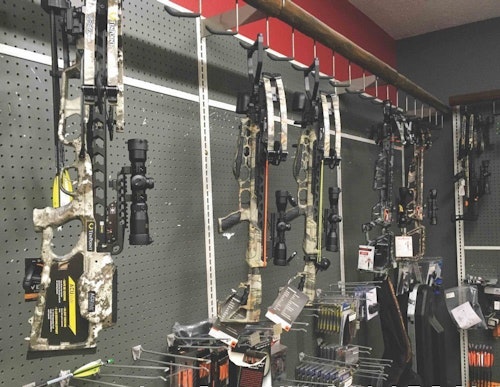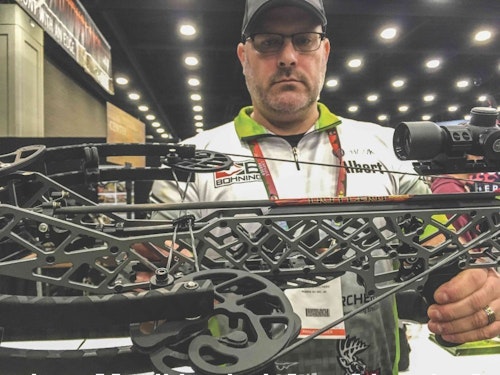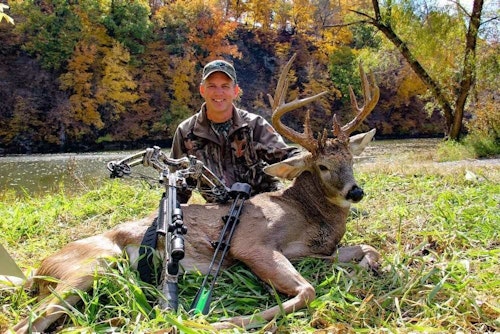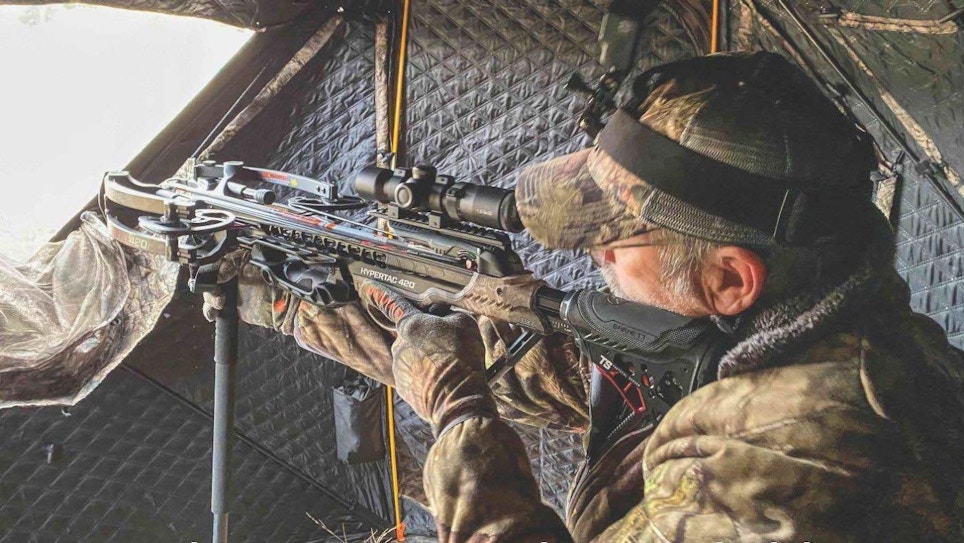At last count, crossbows were legal during at least some part of the archery season in 33 states, and legal for some form of hunting in 49 states. Those numbers increase every year, and so does the number of hunters using crossbows. Crossbow sales continue to increase across the country, but it seems like many archery pro shops are hesitant to jump on board the train. By not selling and servicing crossbows, you’re losing potential customers and missing out on new and additional sources of revenue.
In 2019, Wisconsin DNR (WDNR) published results of a study on crossbow use. When the crossbow was permitted for all-inclusive use in 2014, approximately 2,500 archers switched to a crossbow license, while 1,200 added a crossbow option/authority to their archery license. Since then, the trend has continued for both at lower and roughly equal rates (between 700-900 hunters per year).
For a pro shop owner, that represents a great source for sales. Many of those archers may already be your customers. The regular ones may stop in now and then for arrows and accessories, and perhaps every five or 10 years for a new compound bow. It keeps the lights on, but isn’t going to contribute much toward your retirement account. However, archers making the switch from compounds to crossbows, or simply adding crossbows to their collection of hunting tools, are looking for big ticket items with wider margins.
The WDNR study also found that nearly 10,000 gun-only hunters added or switched to crossbow licenses in 2014. And, the number of gun hunters adding crossbow licenses has remained consistently high at around 8,000 per year since. That’s a tremendous potential source of new customers — if you sell crossbows.
The above represents a broad spectrum of the hunting community. There are two segments where crossbows are especially popular, and Ohio also has some interesting demographics on crossbow users. The majority of Ohio bowhunters ages 7-14 use a crossbow. The numbers start to flip when hunters reach ages 14 or 15 as more young archers switch to compound bows. Around age 40, the number of compound hunters starts declining while crossbow numbers rise. They cross around age 55 (the peak nationwide demographic for hunters), after which crossbow hunters again outnumber compound hunters. Here again, these are just the bowhunters. Add gun hunters and you have a tremendous tool to recruit and retain more hunters, and customers.

Archery Market Trends
Ray Weasner owns and operates Weasner Archery in Bloomville, Ohio, where crossbows have been legal for bowhunting since 1982. He says most of the men and women shooting crossbows are gun hunters who don’t have the time, or aren’t willing to take it to become proficient with a compound, and they buy their crossbows at gun shops. His customers are predominantly older archers transitioning to crossbows, or first-time hunters just getting into archery.
Hailee Daniels, owner of Ontario Archery Supply in Bellville, Ontario, sees similar trends, with many of her customers using crossbows as an entry point to hunting, or due to some physical disability. She also noted that crossbows are appealing to many different customer groups in her region, including 3-D archers, as well as turkey and bear hunters.
According to the Archery Trade Association, estimated bow sales of $192 million comprised 36 percent of the $535 million archery market in 2003, with crossbows representing about two percent of total archery sales. The National Sporting Goods Association’s participation survey has shown steady growth in the archery segment since, up 107.2 percent from 2003–2017, with a predicted continued growth rate of 8.5 percent through 2022. It’s not difficult to see which segment of the archery industry is experiencing the most growth.

Crossbow Categories
During my stint in retail, we were taught to assess the customer before making recommendations. This meant determine what kind of hunter they are: casual or serious. And figure out their budget and overall objectives.
Weasner and Daniels said their crossbow customer base typically fell into one of two categories. Both younger folks and newer hunters tended toward lower-priced introductory models, while older, more experienced customers wanted the best that’s available. Both represent crossbow sales opportunities and illustrate why you should have a range of options.
David Wilkins operates Wyvern Creations, a custom bow shop in New Hampshire, where crossbow use followed a typical progression from handicapped only, through limited seasons, to all-inclusive use. He noted that for a while the crossbow industry seemed to be sharply divided between low-end crossbows, and models priced at $1,500 or more. Companies that specialized in the mid-range price points either went out of business or moved toward one end or the other. Dealers followed suit, as did the dealer network, not carrying mid-price point bows.
It didn’t take long, however, for crossbow manufacturers, dealers and their networks to figure out they were missing out on a high demand segment of the market. As the more successful pro shops have learned, you need to cover the gamut.
At the low end are crossbows that appeal to introductory level or casual hunters. “Having price point bows is absolutely necessary for that customer,” said Wilkins. “Then there’s the cheap factor. Some people just want the cheapest price, and they’ll keep shopping online until they find it.” Unless you have it.
The best option here is crossbow packages. They come with everything your customer will need to get started, and customers can realize sometimes significant savings on accessories, which is a good sales incentive. In some cases, kit bows are ready to shoot out of the box. In others they’re not, which offers yet another opportunity to steer customers toward the pro shop and away from the big box stores and gun shops.
“We try to adapt to different customers’ needs, but we sell the service along with our crossbows,” Wilkins said.
Consider this: You can set up a compound bow for a customer, adding accessories and coming close in terms of bowsight and arrow rest placement, but everything still needs to be dialed in to fit the individual shooter. Crossbows, on the other hand, can be 100 percent turn-key. You can put them together and sight them in at 20 yards, charging a shop fee to do so, or including it as a value-added service to boost sales. You could even test various broadheads and suggest which brand/model performs the best, potentially selling a half-dozen or dozen broadheads and arrows along with the crossbow.
You needn’t worry about low margins on crossbow packages, either. Daniels noted, “The entry-level crossbow customer more often goes with a $500 - $600 kit that includes everything they need to get started, but they usually come back after six to eight months to upgrade as they become more familiar, more comfortable with their bow.” If they had a positive experience the first time, then they’ll likely come back to your shop.
Meanwhile, high-end customers can be a golden goose. “They want more from the get-go,” said Daniels. “They’re often looking for custom bolts, top-grade accessories, soft and hard cases. You name it.” And they keep coming back as technology improves.
Another value-added service is education. “Consumers are demanding more, and manufacturers are trying to provide it while also educating consumers because the dealers are not doing it,” said Wilkins. He cited optics as a prime example. “For a long time, stock crossbow optics weren’t all that good, but there was strong consumer demand for high-end scopes. Optics companies began making specialized crossbow scopes and the most serious consumers bought them, but dealers didn’t. So they stopped making them.”
That trend has reversed, due in large part to higher demand and more discriminating customers. They buy or upgrade to faster crossbows, and their old three dot reticle is inadequate for a bow that might shoot accurately out to 70 yards. They want illumination and a rheostat to adjust it. A very recent trend on top-end bows is rangefinding scopes — another product with big margins — which allow you to range, aim and fire accurately without losing your sight picture.

Service With a Smile
Clearly, adding crossbows to your inventory is a good idea if you want to increase overall store sales. In order to sell them, you’ve got to get customers in the store and keep them coming back, which is increasingly more difficult with the proliferation and convenience of online sales. In addition to sales, Weasner also does service for his customers, one of the most common services being string replacement.
“I re-string gobs of them,” he said. He adds that there are decent margins on the sale of a string — around 35-40 percent — but you also have to add up-front costs and inventory issues. “You have to have the right presses, and different bows require different presses.” Keeping a surplus stock of strings in inventory is also costly, but most can be ordered, and if he can’t get it, Weasner makes his own.
You can also charge for re-stringing, but Weasner prefers not to. “It’s a way to get people in the store, and while they’re here they’ll buy other stuff. On the other hand, if you don’t have what they need, they’ll go somewhere else.” As a side note, Weasner also makes his own venison bologna and summer sausage, and he usually has samples in the store for customers to try. As a result, he sells a lot of seasoning kits and food processing tools.
As noted above, part of the service also includes educating people. “I recommend my customers replace strings every year or two, depending on how much they shoot, and the type of bow,” said Weasner. “You should not go over three years without replacement, and the new speed bows experience a lot of stress, and strings should probably be replaced every year. A new string costs a lot less than a new bow.”
Weasner also does general service such as replacing and repairing trigger boxes, cams and other parts. It’s usually more involved, but service charges cover the cost of parts and labor with room for profit. Sometimes the needed repairs are impossible, but even that cloud has a silver lining. Example: Being in Ohio, Weasner sees a lot of old Horton bows, and because they’re no longer being made, parts are hard to come by. “If you can’t fix it, the customer usually ends up buying a new bow,” he said.
If you own an archery pro shop and you’re not selling crossbows, then you probably should be. In established crossbow states such as Ohio, crossbow hunters now outnumber compound bowhunters. In newer areas, crossbow use is growing, and that trend will only continue as new hunters seek ways to get into archery, older hunters look to stay involved with equipment they can handle, and gun hunters seek ways to expand their hunting seasons and time afield. Finally, crossbow set up and repair require more of an investment in shop tools, but they’re value-added services that get people in the door and keep them coming back.
Sidebar: Selling Used Crossbows
One way archery pro shops might be able to better serve their customers and themselves is through consignment or sales of used crossbows. It’s a more appealing option than with compound bows because the product is basically one size fits all. It might also be more incentive for someone to upgrade, if they know they can get a few bucks for their old bow. Sales-wise, a used crossbow might be a more palatable option for the first-timer, who will eventually be back for a newer, better crossbow. The process doesn’t come without certain risks, so pro shops owners need to make sure all crossbows are in good, serviceable condition, and all sales are as-is and final.






